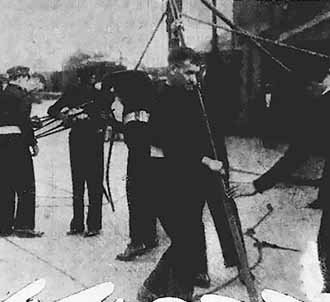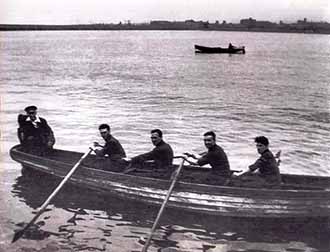January
6 January
In the early hours of the morning of the 6th January, the wind of the previous day veered round to the North-East and blew strongly with squalls of rain and sleet, the wind in squalls reaching a velocity of 45 m.p.h. Owing to a breakdown the Watch House was cut off from telephone communication. Watch was kept all day. After nightfall the squalls became less frequent and violent and there were numerous arrivals of vessels some of which had probably been sheltering under Flamborough Head. Between squalls the weather was clear, and towards midnight conditions being much moderated the watch was terminated.
Source: Annual Report 1935
26 January
On the 26th of January the strong westerly wind of the previous day suddenly veered to the North at midnight and blew with almost hurricane force with blinding hail and sleet, the wind reaching a velocity of 87 m.p.h., the highest recorded here for some years. Watch was kept. About 4 a.m. the wind moderated in force, though still very strong. Strong sea running at daybreak. Outlook stormy. Towards midnight the wind again increased in violence, with very heavy squalls sometimes passing 80 m.p.h.; hail, sleet and lightning alternated with calmer intervals. Continuous watch was kept all day. At dusk a large Steamer entering the harbour was struck by a heavy sea and thrown about broadside on athwart the entrance between the Piers. Fortunately, she recovered and entered in safety. Watch continued until about 9 a. m. on the 27th January.
Source: Annual Report 1935
February
7 February
On the 7th February in the Brigade House, Capt. G.P. Bowles, Inspector of Coastguard North-Eastern Division, presented the “Chronicle Cup”, which had been won by this Brigade for the year 1934, and complimented the Brigade on their high state of efficiency. Capt. J. T. Robson who had captained the team received the Cup and replied on behalf of the team.
Source: Annual Report 1935
25 February
On Monday, 25th February, in the early morning, the Northerly wind increased to gale pace raising a strong sea. About 7.30 a.m., the s.s. “Gogovale” of Glasgow, while entering the Harbour struck the end of the South Pier. Fortunately, however, she recovered and entered safely. Wind N.E. with occasional squalls and snow. Watch was kept all day. Weather gradually moderated and watch was terminated shortly before midnight.
Source: Annual Report 1935
Steamer Strikes Shields Pier
The Glasgow steamer Gogovale (4,586 tons) crashed into the South Pier of the Tyne as she was making Shields harbour after her voyage from Antwerp to Tyne Dock unladen. The Gogovale suffered damage on the port side amidships and part of the deck was smashed, but after a slight delay was able to proceed to the Middle Dock buoys for repair.
Source: Sunderland Daily Echo 25 February 1935
March
3 March
On the 3rd march, Mr Samuel Malcolm, who at the time of his death was President of the Brigade, died at his residence, 78, Fern Avenue, Jesmond. Mr Malcolm was in his 93rd year and in his advanced years was a man of singular vitality in both body and mind. He was one of the founders of the Brigade and for 40 years before his retirement he filled the joint offices of Secretary and Treasurer in an honorary capacity. He was the first Secretary of the Brigade. He took a great interest in the Brigade right up t the last. He was buried at Westoe Cemetery, the funeral being private.
Source: Annual Report 1935
Life-saver Buried
Mr Samuel Malcolm (93), who founded a Volunteer Life Brigade in 1866 and worked for many years with the Tyne Life-boat Society, was buried at South Shields.
Source: Sunderland Daily Echo 21 March 1934
April
May
June
July
6 July
Life Brigade Teams
Volunteer Life-Brigade teams from Tynemouth, South Shields, Roker, and Sunderland South Side are competing on the South Docks parade ground to-day for the Wear Shipowners’ Shield.
Team work in erecting the breeches buoy and individual competitions for throwing the stick and artificial respiration were among the various events.
Source: Sunderland Daily Echo 6 July 1934

In Action – South Shields Volunteer Life Brigade “snapped” during the annual competition for the Wear Shipowners’ Shield, at the South Docks, Sunderland. Teams taking part included Roker, Sunderland South and Tynemouth.
Sunderland V.L.B Lose
Narrow Margin Gives Tynemouth Shield
Sunderland (South Side) Volunteer Life Brigade failed by a narrow margin to win the Wearside Shipowners' Shield from Tynemouth Brigade, the present holders, when the annual competition for the trophy was held at the South Docks on Saturday night.
By their lead of 8.6 over the 1015 awarded the Sunderland team, Tynemouth won the shield for the sixth time since It was first competed for seven years ago.
In the spaces between the huge timber piles on the docks crack life-brigade teams leapt into action on imaginary wrecks with as much vim as though the saving of many lives depended on their speed.
Under the watchful eyes of three judges, safety-jacketed brigadesmen assisted imaginary victims from the breeches buoy as it dragged through a “raging surf,” and men worked feverishly at artificial respiration on an apparently drowned man who tried his utmost to stifle his laughter and look serious.
The competition started early in the afternoon and finished in the evening, the result being announced in Sunderland South Side Brigade House at the Docks.
Judges were Capt. R Harland (Blyth), Capt. T. Watson (Whitburn), and Capt. J. Woods (Seaham Harbour), who are members of the National Life-Saving Companies.
The result of the competition was: — Tynemouth (captain, F. Hudson). 113.1: Sunderland (South Side) (captain. J, J. Hammal), 104.5: South Shields (captain. J. J. Robson), 95.2; Roker (captain, J. Keenan), 69.6.
Source: Sunderland Daily Echo 8 July 1934
31 July
On the 31st July, in connection with the Civic Week Programme, the Brigade gave a demonstration in the evening commencing at 7-30 p.m., going through a complete drill: firing a rocket, landing a man, and restoring the apparently drowned. The demonstration was witnessed by a large number of people. The Deputy Mayor, Councillor S. Lawlan, fired the rocket. During the week the House was open to the public, and more than a thousand visitors were shown over the House by members of the Brigade.
Source: Annual Report 1935
August
5 August

On the 5th August, the usual Bank Holiday Regatta was held at Roker, and a crew from this Brigade was again successful in winning the “Moffat” Cup for competition amongst crews from Volunteer Life Brigades.
Source: Annual Report 1935
September
28 September
On the 28th September, the “Chronicle” Cup Competition took place, the South Shields Brigade and Tynemouth Brigade going through the Drill on the South Shields ground, the ultimate result being that Tynemouth were declared the winners of the Cup, obtaining 213 points.
Source: Annual Report 1935
30 September
On the 30th September, Mr James Whittaker died. At the time of his death Mr Whittaker was the Brigade Watchman and Caretaker of the House. His passing was a real loss to the brigade, for during an association lasting nearly 40 yers he had been a staunch supporter and energetic worker. He was buried at Harton Cemetery and a strong muster of the Brigade attended his funeral.
Source: Annual Report 1935
October
November
30 November
On the 30th November, the Brigade went through its annual Service Drill. The object of a Service Drill is to approach as nearly as possible to actual wreck conditions away from the usual exercise ground. On this occasion the Drill was fixed for the evening so that darkness added to the difficulties, whilst a strong wind with heavy rain prevailed throughout the operations. There was a good strong muster of the Brigade, including several new members. Information was supposd to have been received that a small vessel had been driven ashore near Frenchman’s Point and the rocket apparatus and cliff ladders were taken by motor lorry to Frenchman’s Bay. The gear was then manhandled 100yards to the edge of the cliff. An isolated rock was taken to represent the wreck. A rocket was fired, the hawser hauled out and set up taut and the breeches buoy sent out. Meanwhile the cliff ladders had been brought into position and rolled over the edge of the 60 feet cliffs and a party descended to the beach. H.M. District Officer of Coastguard, Mr R. J. Bressey, was present and complimented the Brigade on the excellent performance in difficult conditions.
Source: Annual Report 1935